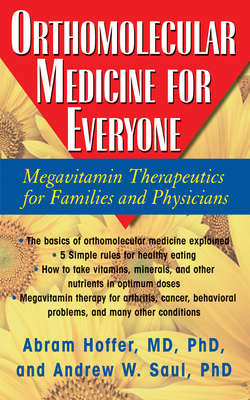Читать книгу Orthomolecular Medicine for Everyone - Abram Hoffer M.D. Ph.D. - Страница 63
На сайте Литреса книга снята с продажи.
Оглавление4
Vitamin C (Ascorbic Acid)
The six-carbon vitamin C molecule (ascorbic acid, C6H8O6) probably was present in the primordial soup in which life developed on Earth, along with vitamin B3 (niacin) and perhaps other vitamins. Smaller than the simplest sugar, vitamin C preceded life by a long time, so it would be surprising if it were dangerous, for life developed and accommodated to molecules already present in the fluid. About 450 million years ago, aquatic vertebrates developed and flourished for about 100 million years, then land animals (reptiles, birds, and mammals) evolved. Fish and amphibians made ascorbic acid in their kidneys; birds are in transition from earlier forms, which used their kidneys, to later forms, which used both kidney and liver, and finally to more recent forms which use only the liver, as do most mammals.
But about 25 million years ago, our ancestors lost the ability to make ascorbic acid. Ascorbic acid resembles glucose in structure, but it is much more reactive chemically. When animals make ascorbic acid, they start from glucose. This series of reactions requires the enzyme gulonolactone oxidase, and humans and a few other species of animals lack this enzyme and so cannot make ascorbic acid. The gene that controlled its formation vanished.
Our earliest ancestors lived on diets rich in ascorbic acid. Uncooked foods in general, and especially fruits, are high in vitamin C. So are the nonmuscle organs of prey animals. The loss of ascorbic acid synthesis did not destroy the individual because there was enough ascorbate in food to maintain life. Enough advantage was gained, by the release of energy that had been required to make ascorbic acid to instead be available for other biochemical processes, that this loss of a gene became an evolutionary advantage. But once the ability to make ascorbic acid was lost, it could not be regained. Later, humans paid an enormous price in disease and death from having to live with mild to severe deficiency of ascorbic acid. As our ancestors ranged farther and farther from ascorbic acid–rich foods, the price became still more costly. The stage before death is scurvy, a major scourge of humankind. For example, far more sailors have died from scurvy than from hurricanes, shipwreck, or cannon fire. Along with humans, guinea pigs and fruit-eating bats have also become totally dependent on external sources of ascorbic acid. Even children know that their pet guinea pigs need vitamin C–rich foods or they will get sick … from scurvy. Our other domesticated animals, especially cats and dogs, appear to be following in our footsteps. Some purebred puppies suffer from hip dysplasia, an indication of canine scurvy.
Classic, really obvious scurvy is seldom seen in industrialized nations. It usually is first seen as a sallow, muddy complexion in a person who suffers loss of energy, fatigue, and intermittent joint pains. Gums become sore and bleed. There are frequent nosebleeds and skin hemorrhages. Eventually, the skin becomes dingy and brown. Teeth loosen, old healed scars open, healing ceases, there is shortness of breath, and, soon after, death. Resistance to infections is also decreased. The Black Death was so terrible because it was superimposed upon preexisting scurvy.1 One-quarter of the population of Europe—25 million people—died. Even then, the common folk associated scurvy with lack of green plants.
The development of oceangoing wooden ships that could sail for many months at a time brought scurvy to the fore. Ships would sail from home with many more sailors than were required because so many would die at sea from scurvy; on some long voyages, half the crew would die. Even after James Lind proved that scurvy could be prevented by eating citrus fruit, it took the British Navy four decades to start issuing juice. The use of lemon juice, it was estimated, doubled the fighting force of the navy, but the forty-year delay cost 100,000 additional casualties.
The Board of Trade waited another seventy-two years before issuing citrus juice to its Merchant Marine. The U.S. Army became aware of it in 1895. Scurvy finally was beaten when Hungarian physiologist Albert Szent-Györgyi (1893–1986) proved in 1931 that ascorbic acid was vitamin C. At first, he tried to call his white crystalline substance extracted from peppers “ignose,” because no one knew what it was. The editor of the journal to whom he submitted his paper rejected this, as well as Szent-Györgyi’s second suggestion, “Godnose.” For this discovery and other essential research, he was awarded the Nobel Prize in Physiology or Medicine in 1937.
